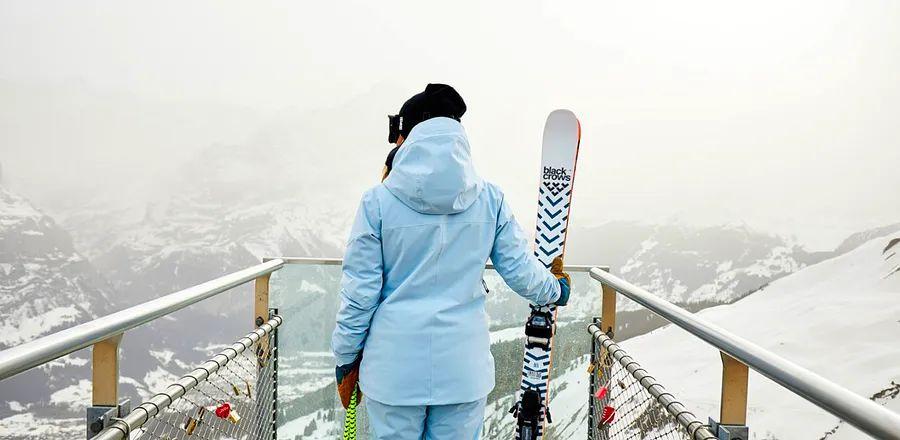Top Ski Gear for the Eco-Conscious Adventurer

You’ve selected the perfect ski resort that matches your style, booked your flights, and are ready to hit the slopes. But don’t forget one crucial detail: the ski gear that will enhance your experience in your winter paradise.
Before you start shopping at your local REI, take a moment to review what you already own in your closet and garage. With the United Nations’ recent warnings about the alarming impacts of climate change, it’s time we all commit to consuming less. Can your parka last another season? Perhaps your ski pants just need a minor repair, like a broken zipper (visit your local tailor) or a small tear (consider these patches). Depending on your location, you might find second-hand shops offering excellent gear that’s new to you.
If you’re a beginner at skiing or only hit the slopes a couple of times a year, renting skis, boots, and poles is probably the most economical and sustainable option. Many resorts have rental services conveniently located near the slopes. Additionally, some shops and online platforms like kitlender.com offer rental options for clothing along with the equipment.
However, in some cases, due to your specific needs and frequency of use, purchasing new ski gear is the best choice. Fortunately, the outdoor industry is making strides to produce ski apparel and equipment that’s much more environmentally friendly. Many brands utilize recycled, repurposed, and sustainable materials in their products. Others collaborate with environmental organizations, steer clear of harmful chemicals like PFCs, use renewable energy sources for their factories, and achieve certifications like B Corp (which signifies a commitment to high social and environmental standards) and Bluesign approval (ensuring that textile products are safe for both people and the planet). Several leading brands are doing most of these things. Best of all, they are making these eco-friendly innovations without sacrificing warmth, waterproofing, breathability, or overall product quality.
If you’re ready to pass along your trusty gear to another skier, consider treating yourself to these eco-friendly alternatives.

Image courtesy of Patagonia
1. Insulated Ski Jacket: Patagonia Insulated Powder Town Jacket
From spearheading the 1% for the Planet initiative to this year’s major announcement that its founder has transferred ownership—valued at $3 billion—to a newly established trust and nonprofit dedicated to fighting climate change, Patagonia, a certified B Corp, has consistently embodied its commitment to environmental stewardship. This ethos will continue indefinitely: any profits not reinvested into the business will be distributed as dividends to support ecological initiatives. The Insulated Powder Town Jacket exemplifies this commitment, as it is Fair Trade Certified and PFC-free, featuring Thermogreen insulation made from 100 percent recycled polyester for targeted warmth. We recommend this waterproof and windproof jacket for particularly chilly days on the slopes, and if the temperatures rise during your afternoon runs, the pit zips offer a convenient way to cool down.

Image courtesy of Norrøna
2. Ski Jacket: Norrøna Lofoten Gore-Tex Jacket
On warmer lift days—or if you’re making your way up the mountain by skinning—a lighter shell, which is an uninsulated outer layer that remains waterproof and windproof, is ideal. The Lofoten Gore-Tex Jacket fits the bill perfectly. Crafted from premium Gore-Tex Pro and featuring articulated elbows, a removable powder skirt, taped seams, and a host of other features, this jacket is a worthy investment despite its somewhat steep price. Additionally, over 50 percent of its synthetic fibers are recycled, and every year, the nearly century-old Norwegian brand contributes 1 percent of its sales to organizations that support sustainability and eco-friendly efforts.

Image courtesy of Blackcrows
3. Snow Pants: Blackcrows Ferus Mechanical Pant
Based in the skiing paradise of Chamonix, Blackcrows designs gear that performs exceptionally in snowy conditions while maintaining an eco-friendly approach. Their Ferus Mechanical Pant (offered in a warmer bib version for women and a traditional pant style for men) features PrimaLoft Black Eco insulation and a 100 percent recycled lining that feels luxuriously soft. The inner ankles and bottom hem are reinforced with abrasion-resistant polyester to guard against damage from bindings and boots.

Image courtesy of Cotopaxi
4. Fleece Midlayers: Cotopaxi Teca Fleece Full-Zip Jacket
Cotopaxi, a carbon-neutral and B Corp-certified brand, excels in producing eco-friendly outdoor apparel. Wrap yourself in its Teca Fleece Full-Zip Jacket, an excellent midlayer for mountain adventures. We love its vibrant colors, recycled fleece, repurposed polyester taffeta construction, and the cheerful llama logo that brings a smile.

Image courtesy of Mountain Hardwear
5. Down Midlayers: Mountain Hardwear Ghost Whisperer/2 Hoody
We’ve already praised Mountain Hardwear’s Ghost Whisperer UL Jacket as a travel-friendly packable down option, but we’re especially fond of the updated—and significantly more sustainably produced—version for those freezing days on the slopes. The Ghost Whisperer/2 features 800-fill, RDS-certified down insulation (which means the ducks and geese from which the feathers were sourced were treated humanely), and all solid colors in this collection are crafted from 100 percent recycled nylon.

Image courtesy of Artilect
6. Base Layers: Artilect Goldhill 125 Zoned Crew and Legging
There are many reasons wool is the preferred material for base layers among snow enthusiasts. It retains warmth, wicks moisture away from the skin, and is naturally antimicrobial (so you can enjoy après-ski without worrying about unpleasant odors). Merino wool, in particular, feels incredibly soft against the skin. Artilect has taken this essential fabric and collaborated with manufacturers to enhance it. The outcome, Bluesign-approved Nuyarn, dries five times faster, is 35 percent stretchier, and 50 percent more durable than traditional ring-spun merino. Additionally, it requires 30 percent fewer resources to produce. You’ll find Nuyarn featured in Artilect’s base layer collection, including the Goldhill 125 Zoned Crew and Legging for both women and men.

Image courtesy of Montane
7. Ski Gloves: Montane Duality Waterproof Gloves
Crafted with 55 percent recycled PrimaLoft Gold insulation, featuring goat leather on the palm and fingers, along with a brushed microfleece lining, Montane’s Duality Waterproof Gloves are designed to shield your hands from the elements. Additionally, their PFC-free DWR exterior coating protects the environment from harmful chemicals. If you prefer mittens, consider the brand’s Anti-Freeze Packable Down Mittens ($85), which also use recycled materials and PFC-free DWR.

Image courtesy of Salomon
8. Helmet: Salomon MTN Lab Unisex Helmet
Gone are the days of hitting the slopes (unsafely!) with just a pom-pom beanie. From Aspen to the Alps, wearing ski helmets has become standard practice. Eco-conscious powder enthusiasts should consider the lightweight MTN Lab Unisex Helmet, which boasts patented technology for maximum energy absorption, providing protection against both oblique and vertical impacts. It is also made with recycled materials and features a 100 percent natural merino liner.

Image courtesy of Zeal Optics
9. Goggles: Zeal Optics Hangfire
Designed by Zeal Optics, a proud member of 1% for the Planet, and produced in a factory powered by solar energy that recycles all fluids, water, and excess frame materials, the Hangfire goggles also come with a strap made from sustainably sourced, bio-based yarn. When you order a pair online, they will be delivered in fully recyclable packaging. Mother Earth definitely approves of these eye protectors. With their rimless design, excellent peripheral vision, helmet compatibility, and polarized lens option, we believe you will love them too.

Image courtesy of Icebreaker
10. Neck Gaiter: Icebreaker Unisex Merino Flexi Chute
Your helmet keeps your head and ears warm, your goggles protect your eyes and the bridge of your nose, and your parka likely shields part of your neck. However, on particularly frigid days when each snowflake feels like a pinprick on your face, you’ll want an additional layer to cover your cheeks. Trust us on this one. For an eco-conscious choice, opt for Icebreaker’s Unisex Merino Flexi Chute, made entirely from natural and renewable wool. Interested in how the brand emphasizes sustainability? Icebreaker’s annual transparency report delves into the details of its business practices, supply chain, materials, and corporate objectives.

Image courtesy of Smartwool
11. Ski Socks: Smartwool Ski Intraknit Over the Calf Socks
If you want to avoid frozen toes, steer clear of cotton socks while skiing. Wool, possibly combined with recycled nylon for enhanced durability and some elastane for stretch, should be your preferred choice for this layer. Smartwool’s Ski Intraknit Over the Calf Socks meet these criteria, and the brand is also dedicated to eco-friendly practices, aiming to become “climate positive” by 2030 through the use of 100 percent regenerative materials and fully recyclable products. Additionally, over 90 percent of Smartwool’s wool comes from ZQRX-certified growers who prioritize animal welfare, sustainability, and social responsibility through regenerative agriculture practices.

Image courtesy of Blizzard
12. Skis: Blizzard Black Pearl 88 and Brahma 88
For those who ski frequently enough to justify investing in their own gear, the Black Pearl 88 for women and the Brahma 88 for men are excellent choices. Tailored for intermediate to advanced skiers, these reasonably priced skis perform admirably on groomed runs and in fresh powder. Additionally, they are manufactured in a facility that operates with 20 percent solar power and 80 percent hydro power. Keep in mind that the Brahma comes with a slightly higher price tag due to its construction featuring two sheets of metal, compared to the single sheet used in the Black Pearl.

Image courtesy of Scarpa
13. Ski Boots: Scarpa 4-Quattro SL
While the expense of ski boots is undeniable, the impact of poorly fitting boots on your day on the slopes is equally clear. If you're ready to invest in your own pair, Scarpa offers an environmentally conscious choice as it works toward becoming a B Corp. Their solar panels reduce carbon emissions by 320 tons annually, and specifically, the shells of the 4-Quattro SL ski boots are crafted from Pebax Rnew, a bio-based polymer derived from castor oil rather than petroleum.

Image courtesy of Grass Sticks
14. Ski Poles: Grass Sticks Original
Bamboo isn’t just for pandas! According to the creators of Grass Sticks, this renewable resource absorbs more CO2 and generates more oxygen than any other plant, making it an excellent material for ski poles. Its tensile strength competes with that of steel, while its compressive strength surpasses that of concrete. Plus, unlike the metals typically used in ski poles, bamboo isn’t extracted from the Earth. You can personalize your set with a strap made from 100 percent recycled polyester.

Image courtesy of CamelBak
15. Backpack: CamelBak Powderhound 12 Hydration Pack
As mentioned in our guide to high-altitude locations like Colorado, staying hydrated is essential for preventing altitude-related headaches and even severe altitude sickness. But who wants to lug around a bulky water bottle in their ski jacket or stop after every run for a drink from the water fountain? A great solution is the Powderhound 12 Hydration Pack by CamelBak, a POW partner. This stylish backpack features a two-liter water reservoir that can be easily accessed through an insulated tube, and it’s crafted with PFAS-free DWR, completely free of PFCs.

1

2

3

4

5
Evaluation :
5/5